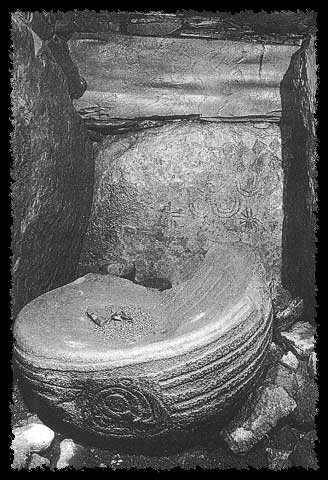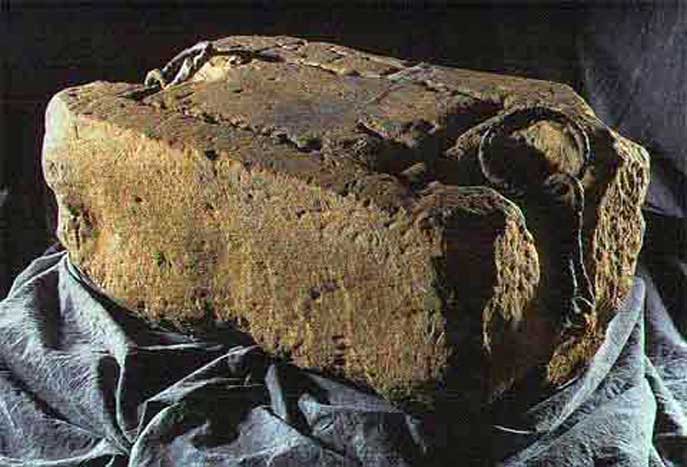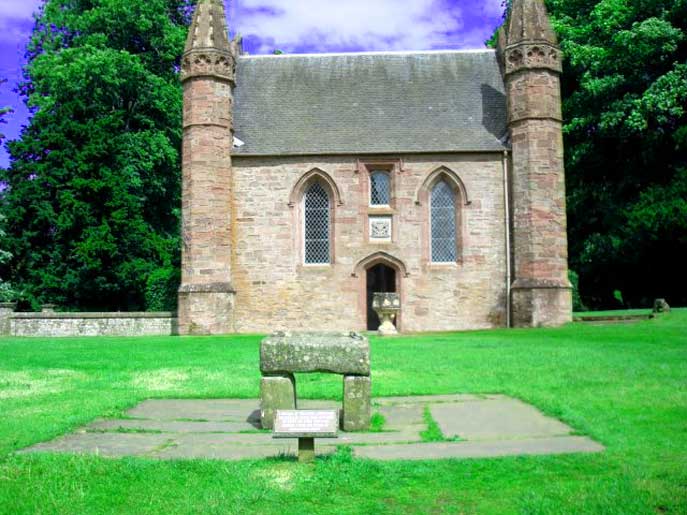APPENDIX II, THE STONE OF DESTINY |
|||
|
According to legend, this ancient stone had been brought to Scone from Dalriada, (Argyll) by Kenneth Mac Alpin c. 850 A.D. It had previously been brought to Argyll from Ireland by Fergus Mac Erc, a Dalriadan king, sometime in the 5th century. Prior to this it had been transported to Ireland via Spain by Scota, the daughter of an Egyptian Pharaoh; both cautiously identified by Egyptologist Lorraine Evans in her book “Kingdom of the Ark” as Princess Meritaten and her father, Pharaoh Akhenaten. Scota is supposed to have fled Egypt with her Greek husband Gathelos, or Gaidelon, and his followers sometime around 1335 B.C. following a rebellion in which Akhenaten was overthrown by Horemheb, the army commander. The ‘Scots’, it is said, after a period in Spain followed by an interval in Ireland, eventually settled in Dalriada and took their name from this Princess Scota, to become the people known throughout history as the ‘Scotti’. Some intriguing evidence of an Egyptian contact and influence during this period does appear to have been found in Tara, Ireland, when an ancient stone-age burial chamber, known as the ‘Mound of Hostages’ was excavated in 1955. Although the mound itself is Neolithic (c.3000B.C.), the remains of a much later Bronze Age inhumation were discovered, which turned out to be that of an 18 year old youth who was buried with a bronze dagger and pin, and wearing a necklace of Egyptian ‘Faience’ beads. These beads, a type of ceramic, were found to be of genuine Egyptian origin and were quite unknown in Northern Europe. The skeleton was carbon dated to c.1350 B.C. and this date, as we have seen, given the usual hundred years or so normally allowed for correction either way that is such a feature of carbon dating, was just around the time that Scota and her husband are supposed to have fled Egypt. The problem with all of this is that Scota does not appear to be an Egyptian word. It looks like Greek, and, recalling that Scota’s husband was a Greek, and the tenet that the Greeks are reputed to have a word for everything, we can fairly confidently surmise that ‘Scota’ must indeed mean something. Before his readers reach for their Greek dictionaries, however, the author begs their forbearance, and asks them to read a little further. The stone which currently lies in Edinburgh Castle, along with the Honours of Scotland, and is reputed to be the same one which King Edward I of England stole in 1296 A.D. measures approximately 26 ½ x 16 ½ x 10 ½ inches (670 x 420 x 265 mm). It is acknowledged by geologists as being of Scottish sandstone, and may have been quarried in the region of Scone near Perth. This rectangular block of sandstone is considered by a great many people to be the very stone which Kenneth Mac Alpin reportedly brought with him from Argyll to Scone over a thousand years ago. Yet, if we take the trouble to compare this coronation stone with the stone’s early descriptions, we get quite a surprise. A clear and contemporary eyewitness description of the ‘Stone of Scone’ was made by an Englishman, Walter de Hemingford (also known as de Guisborough), who attended the coronation of John Baliol in 1292 A.D. He depicted it as “Concavus quidem ad modum rotundae cathedrae confectus”, i.e. “hollowed and made in the form of a round chair”. The 14th century English ‘Chronicles of Melsa’ also describe the Stone of Scone as being “hollowed out, and partly fashioned in the form of a round chair”. The coronation stone certainly has an incised groove forming a rectangular panel measuring 17 x 9 inches (430 x 230 mm) on its upper face, but this is not the same as being ‘hollowed out’. Neither is the shape of the stone round, nor does it resemble a throne or chair by any stretch of the imagination. The name ‘The Stone of Destiny’ has come to us from a poor English translation of the Gaelic words ‘Lia’, a great stone, and ‘Fàil’, meaning fatal; hence ‘fate’, and subsequently ‘destiny’. However, the ‘Lia Fàil’ was originally known to the Irish as the ‘Lia Faileas’, and Faileas doesn’t mean fate at all, but rather spectral, or spiritual shadow. It appears that this confusion has come about from a perfectly simple word contraction made a very long time ago by an Irish scribe, and the error of mistaking ‘fàil’ for ‘faileas’ has continued without question ever since. Irish legends inform us that the Lia Faileas was one of the four great treasures given to the Celts by the De Danaans, a mythical god-like people of early Ireland; the other three treasures being an invincible sword, a fiery spear red with blood, and a cauldron of plenty from the fabled cities of Gorias, Finias and Murias respectively. The Lia Faileas, exclusively for use in the coronation of kings, was gifted from the city of Faileas, which means ‘the Place of Shadow’. This brings us neatly to the word ‘Scota’ (the Pharaoh’s daughter), which we find is not a person’s name at all, but is indeed a Greek word, meaning ‘darkness, shadow, obscurity and secrecy’. The great stone, we recall, was described as being round and hollowed, so it should come as no surprise to us to learn that the word ‘Scotia’ is an archaic architectural term which was used to describe a sunken moulding, or a hollow, so called from the dark shadow it casts. In other words, our Lia Faileas. From what we have therefore discovered, it now seems that the old legends are correct in essence, except that the Scots or Scotti took their name not from the Pharaoh Akhenaten’s daughter, Meritaten, otherwise known to us as Scota, but from her Greek husband Gathelos’ great stone talisman; a sacred throne that they and their tribe took everywhere on their wanderings, eventually to end up in Scotland.
To summarise: The Gaelic words Lia Faileas and the Greek words Scota or Scotia mean the same thing in the end, which is ‘the great stone of spiritual shadow, or spectral darkness’. It was round, hollowed, and partly shaped like a chair or throne. And no less an authority than the Roman historian Pliny the Elder (23A.D.-79A.D.) tells us that, “in Persia, a lens shaped stone was considered necessary at the consecration of a king.” Say what one may, but this certainly does not describe the block of sandstone that sat in Westminster Abbey for seven centuries. Kenneth Mac Alpin’s throne has disappeared, probably lost during the Wars of Independence. The ‘Stone of Destiny’ lying in Edinburgh Castle today may have been used by the Picts as part of the installation ceremonies for their kings, perhaps like some form of footstool upon which an oath was taken, and it may have been used similarly by King Kenneth and his heirs. It is unlikely that we will ever know for sure. What we do know is that it was not the actual throne upon which the ancient kings were crowned. If only we knew where it was… Perhaps a good place to start would be the site of the Abbey of Scone that was sadly demolished during the Reformation in 1560. A proper archaeological dig might just give us what we are looking for. We may even find the final resting-place of Robert the Bruce’s grandson, King Robert the Second (died 1390), who was buried somewhere within the Abbey. Finally, consider this quotation from a book which was published in 2000 called “Uriel’s Machine”, written by Christopher Knight and Roger Lomas. They are discussing the 5000-years-old burial mound at Newgrange in Ireland, closely associated with tales of the De Danaans and High Kings. “…we turned left up the Boyne valley, in the general direction of the Hill of Tara where the ancient High Kings of Ireland were acclaimed by placing their foot on the Lia Fàil, the Stone of Destiny. Then, through the trees across the river, we suddenly saw the great white wall of Newgrange on the skyline.” “…we had to stoop to walk up the narrow tunnel which was lined with enormous slabs of rock. The plan view of the chamber is in the form of a cross, and in each of the arms there is a beautifully worked stone basin…” These ‘basins’ are hollowed out on the top, and would serve admirably as thrones. There is a particularly fine example of one of those stone basins inside the Neolithic chamber at Knowth, further along the Boyne valley. It is round and decorated with engravings. No one knows the purpose of these basins, nor just how old they are, yet they were obviously of some great significance. How coincidental that the round one should match so exactly the descriptions that we have of the Stone of Scone. Was each one of these basins a ‘Lia Faileas’; and, perhaps more importantly, did a round one make its way to Scotland? The author’s research satisfies him that ‘Scota’ is a Greek word that means spiritual or spectral shadow. But he would like to draw the reader’s attention toan Egyptian word which, if not exactly like the Greek word Scota, bears a strong enough resemblance to that word in its meaning and pronunciation to merit its consideration in this work. It may well pre-date the Greek word by thousands of years, and, if anything, only adds to the author’s argument about the ‘Stone of Destiny’ being a misinterpretation of the original meaning which was the ‘Stone of Spiritual, or Spectral, Shadow’. The ancient Egyptians believed that a human being consisted of five separate parts or elements. Those were the body itself (‘ha’), the personality of the person (‘ba’), the life force of the person (‘ka’), the name of the person (‘ren’), and, most significantly from our point of view, the shadow of the person. The shadow of the body was considered an important and integral part of an individual and its name, according to Egyptologists, was the ‘shut’. This word ‘shut’ obviously has links to all similar sounding words of Indo-European and Aryan origin that have connotations with the shadow or spirit of the dead. The list seems endless. In English we have ‘shade’. In the Celtic languages we have Welsh ‘ysgod’, Gaelic ‘sgath’ and Cornish ‘scod’. In Gothic we have ‘skadus’ and we are already aware of the Greek word ‘scota’. For the simpler S or SH sound we can travel even further back in time and find in Hindi ‘saya’, and in Sanskrit ‘chaya’ both of which have similar meanings to those above and are likely to have been their progenitors. It is, however, with the Egyptian word ‘shut’ that we are most concerned, as we are attempting to define the link between the Princess Scota and the so called Stone of Destiny. The hieroglyph for this word is shown in two parts and consists of a sunshade, identifying the S or SH sound, and a loaf of bread, identifying the T sound. No hieroglyph was shown for the U sound. Egyptian, in common with many ancient scripts, rarely showed vowels in words and it remained to readers to interpret subjectively the sounds of words from their context within a sentence. ‘Shut’ may not have had a U vowel sound at all. It is just as likely to have been pronounced with an O sound, i.e. like ‘Shot’. Could our word ‘Scota’ have developed, perhaps via Greek, from a metamorphosed form of the Egyptian word ‘Shut’, the ‘spiritual shadow’ of a person? It’s not impossible. We cannot be sure at this distance in time just how the ancient Egyptians pronounced many of their words. They may have pronounced the SH in the word ‘shut’ with a quite discernible guttural sound, a bit like Schut (ch as in loch) or Schot. Indeed, the English word ‘shade’ was itself originally written ‘sceadu’. It is a fact that written alphabets are often quite inefficient at conveying the guttural sounds of many words. There is another hieroglyph that the Egyptians made use of to convey the S or SH sound. It is a long, horizontal rectangular shape and was, apparently, the plan view of an artificial basin. We saw above that stone basins were important to the people who installed them in the chambered cairns at Knowth and Newgrange, though we know not why. The significance will not be lost on the reader however, that the S, or SH sounds, were identified to the ancient Egyptians by the hieroglyphs for both a sunshade and a basin. |
 |
REX PICTORUM |
Back to Top
Return to Paisley T. A. website
© Ron Henderson 2008-09


